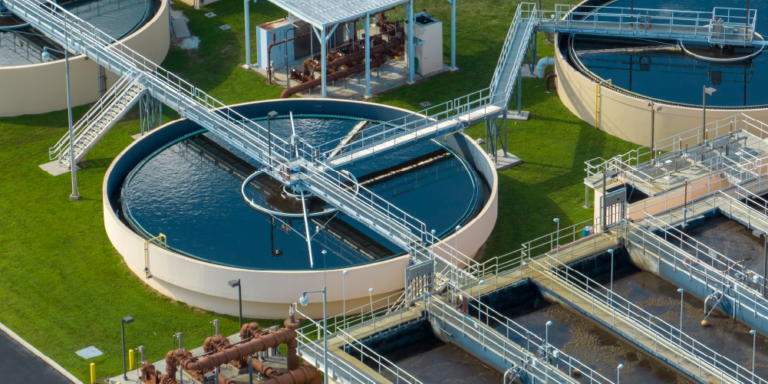— 11 min read
Water Infrastructure: Managing Water & Wastewater Projects


Last Updated Jun 11, 2024

Jacob Kunken
Solutions Engineer, Heavy Civil
28 articles
Jake Kunken currently works as Solutions Engineer for Procore's Heavy Civil division. He brings 14 years of experience working in various construction roles in New York and Colorado, including laborer, assistant carpenter, carpenter, assistant superintendent, superintendent, construction manager, safety manager, and project manager. Jake also spent time in EHS as an environmental engineer for Skanska. He’s worked on more than 40 commercial projects from ground-up, to heavy civil, hospital work, and tenant improvement. Jake studied Ecological Technology Design at the University of Maryland.

James Hamilton
Writer & Producer
85 articles
James Hamilton is a writer based in Brooklyn, New York with experience in television, documentaries, journalism, comedy, and podcasts. His work has been featured on VICE TV and on The Moth. James was a writer and narrator for the show, VICE News Tonight, where he won an Emmy Award and was nominated for a Peabody Award.
Last Updated Jun 11, 2024

Most buildings have a plumbing system that would be worthless if it couldn’t connect to the elaborate system of pipelines, treatment plants, pump stations and storage structures that make up an area’s water infrastructure.
Water infrastructure is the systems, structures and equipment that move and treat water. It includes delivering safe drinking water to people and communities, as well as processing and disposing of wastewater. The construction and maintenance of water infrastructure is the primary way most areas access clean water, which is crucial for economic development, food and energy production, and life itself.
This article explores the construction of water and wastewater infrastructure, including common roles in the field, best practices, and unique aspects of each phase of construction.
Table of contents
The Basics of Water Infrastructure Construction
Water and wastewater infrastructure projects are usually launched to meet an area’s growing demand for water and wastewater treatment or to repair previously existing and outdated infrastructure. Most projects are commissioned by a government agency, either at the federal, state or local level. Some municipalities will partner with a private company, who will manage the project’s construction, operation and maintenance.
Water infrastructure projects are often extremely complicated, for a number of reasons. They often depend on connecting to a water source that is controlled and protected by the state or federal government.
Further, they must integrate into a local municipality’s master plans and be reflected in the municipality’s as-builts. Many water and wastewater pipelines run underneath or alongside roads, so installation or repair work often must be coordinated with the government agency managing roads. Not surprisingly, water infrastructure projects often take years to complete and are extremely expensive. Some municipalities put off these projects for as long as possible, either because they don’t have the money — or have allocated the money elsewhere. This can result in water infrastructure falling into disrepair or becoming dangerously outdated.
Water infrastructure includes many components that all need to be installed and functioning correctly for the whole of the infrastructure to be effective. These might include:
- Pipes and pipelines
- Pump stations
- Reservoirs
- Water treatment facilities, including equipment to clean the water such as settling tanks, air ration tanks, and chemicals
- Wastewater treatment facilities, including equipment to collect and treat wastewater, such as grit chambers, settling tanks, aeration tanks, reactors and bioreactors, and chemicals and tools for disinfection
- Dams and canals
Learn more about common infrastructure projects in construction.
The Water Infrastructure Construction Process
There are unique elements to each phase of constructing water infrastructure projects. Below we’ll explore what takes place during each of these phases.
Planning
Water infrastructure projects usually begin by determining if an area has a need for more water, more wastewater capacity or that the existing infrastructure is outdated or underperforming. Most of these projects are commissioned by a government agency. However, the process can also be initiated by developers, particularly if they are attempting to construct a new neighborhood, subdivision, or economic center that will have an extensive need for water.
Additionally, extensive analysis is usually conducted to determine whether a project will be feasible, particularly in regard to the availability of water and funds to complete the project. Analysis usually includes:
- Feasibility studies
- Flood risk assessments
- Geotechnical analysis
- Life cycle assessments
- Diagnostic studies on existing facilities
A municipality will often hire an engineering firm to design the project, a process that can take anywhere from six months to several years. The process usually includes many elements, including receiving approval from numerous stakeholders and coordinating how to connect the new project to the existing infrastructure of the city, county, and state.
While water infrastructure might have similar elements in many places, planning must account for the variables and obstacles that are unique to the area the project will be located in or be moving through. For example, the process and materials for installing pipelines is different if those pipelines will likely need to withstand an earthquake. Similarly, infrastructure located in flood plains will rely more heavily on water pumps.
The many components that comprise water infrastructure can make planning a complicated and multifaceted process, as each component has different considerations that need to be made.
| Water treatment plant | Factory-like facilities that utilize a variety of mechanical and chemical processes to supply millions of gallons of water daily. Have specific requirements for a suitable site, including size, proximity to a water source to pull from, and proximity to a water source to discharge into |
| Wastewater treatment plant | Factory-like facilities that collect, treat, and dispose or reuse wastewater. The treatment of wastewater requires multiple steps of mechanical, chemical, and biological processes. Usually located close to a body of water, where treated water can be discharged, after meeting federal standards and regulations for disposing of wastewater safely. The U.S. Environmental Protection Agency (EPA) provides guidelines and studies to help plan for safe effluent disposal. |
| Pipelines | Pipes are often underground and connect parts of the infrastructure, such as the water source to the treatment plant or the treatment plant to homes. Built horizontally, so conditions vary dramatically across the path of the project. Often run underneath or alongside roads, so they can involve coordination and collaboration with the agency managing the roads. |
Preconstruction
Once the design is complete, the government agency will usually open the project to bids. There are typically only a handful of general contractors (GCs) qualified to execute specialized projects of this magnitude, so agencies will often make an effort to share the project with a national pool of candidates. GCs are bidding to work on a project that is already designed, but the process is dynamic and usually requires them to help update, revise and improve the designs throughout preconstruction and construction.
Wastewater treatment plants are often particularly expensive to build and maintain due largely to their specialized needs for equipment, location and regulatory requirements. Cost estimates often need to consider the following:
- Capacity requirements: Cities like Raleigh need facilities to handle tens of millions of gallons daily (MGD). New York City has numerous plants processing hundreds of MGD. The EPA has guidelines for communities with less than 10,000 people or daily flow of less than one MGD.
- Equipment: This might include equalization basins, oil-water separators, primary and secondary clarifiers, ultrafiltration units, reverse osmosis units, gravity filtration systems, and micro screens.
- Sequencing: Upgrading a system can be difficult because sewage must continue to be treated throughout construction. Renovation projects often need to be done on tight timelines, in particular order, or with temporary treatment methods.
- Regulatory costs: The EPA has specific permits and programs, depending on how wastewater will be disposed of.
- Land use: Municipalities often try to save money by placing plants on former dumping sites. This can present contamination risks and add costs related to cleanup.
Many water infrastructure projects rely on an extraordinary amount of concrete. Treatment facilities are made largely of concrete, as are many underground pipelines, reservoirs and dams. One of the most important parts of preconstruction is making plans to source, procure or manufacture enough concrete. Some large projects will have concrete plants built on the jobsite so that they can have a steady, readily available supply.
Other GCs will line up deliveries from numerous providers well before the pour date, to ensure they will have enough.
Construction
The pipeline construction process usually happens in three phases: excavation, installation and finishing. Because of the length of most pipelines, the project is often broken into segments so different teams can work at the same time. For example, a team might trench for a dozen miles to remove the soil. Once that’s completed, they might begin on the next segment, while an installation team works on the first twelve miles.
However, the changing conditions across the many miles a pipeline stretches means many variables pop up, ranging from weather to unexpected changes in the soil. GCs are constantly looking for potential alternatives for methods or materials to keep the project moving forward and avoid delays.
Post-construction
Completing a water infrastructure project requires extensive inspections and testing to ensure the system is functioning correctly. GCs will routinely conduct inspections throughout the build, but many government contracts require a formal inspection by a third-party organization before the facility can be used. Most states are required to inspect wastewater facilities for compliance with the National Pollutant Discharge Elimination System (NPDES). The EPA provides guidelines for inspecting other components of water infrastructure, such as water storage facilities.
After construction, water infrastructure facilities will continue to undergo regular inspections and constant monitoring to ensure the system is treating water effectively. Drinking water is regularly checked to ensure it’s safe for consumption by testing for bacteria, microorganisms, chemicals such as chlorine or heavy metals, connectivity and pH levels.
Read more on working with authorities having jurisdiction in construction.
Because water infrastructure has major implications for the entire region it is located in, official as-builts for the town, county and state will need to be updated to reflect the finished project. There are usually many closeout documents, as the owner or manager will need proof of inspections, operation and maintenance manuals and commissioning reports.
Roles and Responsibilities in Water Infrastructure Construction
Here are a few common characteristics of GCs and engineering firms working in water infrastructure construction.
| General contractors | There are usually only a few GCs qualified and available for water infrastructure projects. Municipalities need to know that a GC has the experience to finish such a high-stakes project, is established enough to receive insurance for it, and has the finances in case a delay occurs and they’re on the hook for liquidated damages. GCs often need to help update and revise the project drawings based on constructability, cost analysis, and available materials. They also often do extensive analysis during the estimating process and prior to mobilization to prepare for construction. For a pipeline, this might include assessing weather patterns, flood patterns or doing additional geotechnical evaluations. |
| Engineers | Engineering firms often complete water infrastructure designs before the project is opened for bids to GCs. Engineers work to ensure elements of a project will last as long as intended, with a manageable amount of maintenance, while also considering how facilities might be able to be expanded to meet future demand. Their designs should be able to withstand extreme weather or disasters depending on the area, such as earthquakes in California or flooding in New Orleans. Engineering firms that work in water infrastructure are often very large and have specialists in civil, hydraulic, structural, electrical, mechanical and environmental engineering. |
Common Challenges in Water Infrastructure Construction
There are a few common challenges when building water infrastructure.
Projects must endure an uncertain future.
Water infrastructure projects are supposed to last for decades with a manageable amount of maintenance required. Some plans aim for plants to last for 50 years, while others go up to 100. Not only does this require accounting for extreme weather and potential disasters, it should also account for the potential of increased demand for water in the future.
Projects take a long time.
Water infrastructure can take years to be designed, and even longer to build. This is in part due to the scale of the projects but also to the red tape that needs to be cleared to get them done. Technology is often installed years after it was selected, which can create the risk of the technology being behind the latest innovations. Stakeholders strive to build systems with the ability to grow into the future.
Water infrastructure is expensive.
Part of the reason water infrastructure in the US is so outdated is because these projects are extremely expensive and most municipalities have allocated that money elsewhere or they don’t have it. Without a budget for building new facilities and maintaining old ones, water infrastructure can easily become outdated or dangerously ineffective.
Many stakeholders are involved.
Projects require coordination with many different stakeholders. Projects could feasibly be commissioned by a county, pull from a federally controlled body of water, and run through numerous towns. Additionally, each project will usually have an engineering firm and a GC involved.
Some projects have a private company that will manage the water treatment facility once it's completed. Navigating the specific needs and desires of so many stakeholders requires continuous deliberate and transparent communication.
Stay updated on what’s happening in construction.
Subscribe to Blueprint, Procore’s free construction newsletter, to get content from industry experts delivered straight to your inbox.

Best Practices in Water and Wastewater Construction
There are a few things that almost always improve a water infrastructure project.
Successful Document Management
The high number of stakeholders means organizing and sharing documents with many people is extremely important. Also, water infrastructure projects require referencing, revising, and updating project documents. Digital document organization systems, like Procore, can help to manage the immense number of drawings, RFIs, submittals and invoices from numerous subcontractors.
Adaptability and Problem-solving
Unexpected delays or issues on such large-scale, complex projects are almost inevitable. GCs should be versed in a number of planning and scheduling techniques, such as CPM or pull planning, to be able to prioritize tasks, identify lag time, and increase efficiency.
Water Infrastructure is Relied Upon by Everyone
Water infrastructure in the U.S. is a sprawling, masterful feat of ambition and vision. Hundreds of millions of people rely on water and wastewater systems to trust that when they turn on a faucet or flush a toilet, the water flows where it should. The demand for water infrastructure construction works is likely to continue increasing for years to come.
Was this article helpful?
Thank you for your submission.
100%
0%
You voted that this article was . Was this a mistake? If so, change your vote
Scroll less, learn more about construction.
Subscribe to The Blueprint, Procore’s construction newsletter, to get content from industry experts delivered straight to your inbox.
By clicking this button, you agree to our Privacy Notice and Terms of Service.
Thank you!
You’re signed up to receive The Blueprint newsletter from Procore. You can unsubscribe at any time.
Categories:
Written by

Jacob Kunken
Solutions Engineer, Heavy Civil | Procore Technologies
28 articles
Jake Kunken currently works as Solutions Engineer for Procore's Heavy Civil division. He brings 14 years of experience working in various construction roles in New York and Colorado, including laborer, assistant carpenter, carpenter, assistant superintendent, superintendent, construction manager, safety manager, and project manager. Jake also spent time in EHS as an environmental engineer for Skanska. He’s worked on more than 40 commercial projects from ground-up, to heavy civil, hospital work, and tenant improvement. Jake studied Ecological Technology Design at the University of Maryland.
View profile
James Hamilton
Writer & Producer
85 articles
James Hamilton is a writer based in Brooklyn, New York with experience in television, documentaries, journalism, comedy, and podcasts. His work has been featured on VICE TV and on The Moth. James was a writer and narrator for the show, VICE News Tonight, where he won an Emmy Award and was nominated for a Peabody Award.
View profileExplore more helpful resources

From “What Is” to “What If” in Construction
In this episode of The Power of Construction, futurist Nikolas Badminton challenges the industry to reimagine what’s possible when we move from “what is” to “what if.” Rather than planning...

Transforming Construction Project Management With Predictive Analytics
Construction leaders who can correctly identify project challenges before they arise can more easily sidestep them. This saves time, money and significant delays. Predictive analytics attempts to forecast future outcomes...

Capital Project Management: A Quick Guide for Construction Pros
With aging infrastructure and new technology needs, capital projects will remain a high priority for communities around the world in the coming years. Effectively managing capital construction projects is necessary...

Avoiding The App Trap: Overcome Financial Silos to Connect Field & Office
For general contractors working on razor-thin margins, rework and project delays are more than simple inefficiencies — they are major threats to the bottom line. For years, GCs have attempted...
Free Tools
Calculators
Use our calculators to estimate the cost of construction materials for your next project.
Templates
Find a template to help you with your construction project tasks.
Material Price Tracker
Get the latest U.S. retail prices and view historical trends for common building materials.
Glossary
Explore key terms and phrases used in the industry.
